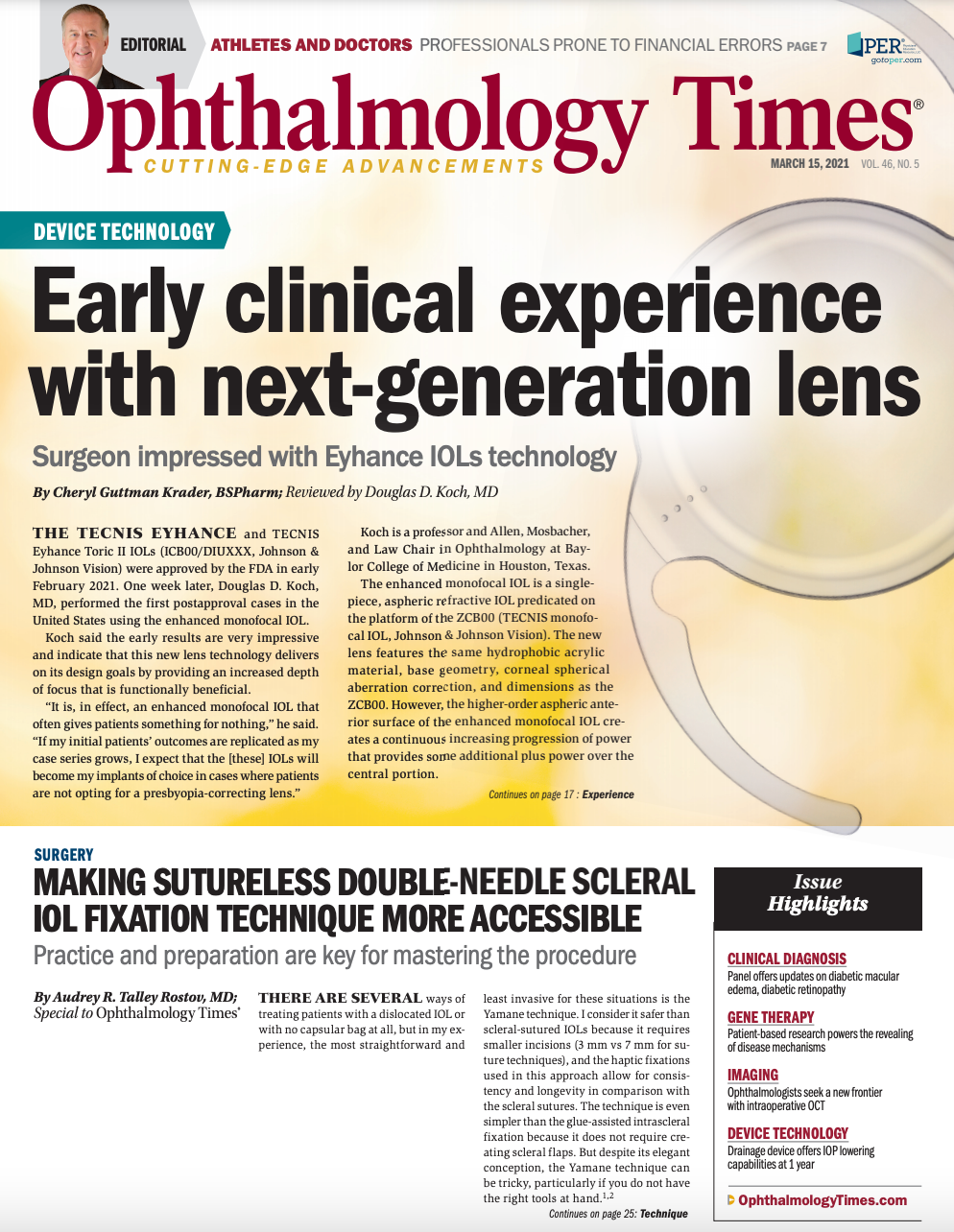Publication
Article
Digital Edition
AI enhances customized myopic LASIK with ray tracing optimization
Author(s):
Novel technique provides another option for normal and irregular corneas.

This article was reviewed by A. John Kanellopoulos, MD
The initial results of customized myopic LASIK using automated ray tracing optimization offer improved and predictable results.
The procedure is driven by artificial intelligence (AI) and represents a clear step forward in LASIK technology.
The roots of the technology are based in topography-guided treatments introduced in Europe in the early 2000s, and the treatment approach grew into the Athens Protocol that combines topography-guided and partial transepithelial PRK and corneal crosslinking.
Related: IOLs offer great vision, low risk profile for myopia
“The topography-guided treated were used to treat sick or problematic eyes, with enlargement of optical zone and treating irregularities such as those seen in keratoconic eyes,” noted A. John Kanellopoulos, MD, from the LaserVision Clinical and Research Eye Institute in Athens, Greece, and New York University Medical School.
The advances in the technology are demonstrated by the surgeon’s ability to treat, for example, a herpetic scar.
The topography-guided procedure could return the cornea to a normal state; in contrast, before the availability of the technology, a corneal transplant might be considered in a patient who was contact lens intolerant.
One lesson learned because of the new ability to treat irregular corneas is that the technology—that is, topography-modified refraction (TMR)—also can be used to treat normal eyes, he explained.
"Use of TMR in routine myopic eyes not only achieves emmetropia but also pushes the envelope to achieve significant gains in lines of vision postoperatively,” Kanellopoulos said.
Related: Tips to chart a course for safe, effective refractive surgery
This technology was initially theoretical and difficult to perform, Kanellopoulos recounted, because of the extensive team diagnostics required and calculations by the surgical team.
The advent of ray tracing first validated the effort to push refractive surgery beyond wavefront-optimized treatments and standard clinical refractions to the next level.
Testing the method
Kanellopoulos and Dylan Stevens, MD, evaluated both eyes of 25 cases in a consecutive case series that were treated with femtosecond laser-assisted myopic LASIK.
The eyes were evaluated for all refractive parameters. Stevens also is from the LaserVision Clinical and Research Eye Institute in Athens, Greece, and New York University Medical School.
The difference in these procedures from the standard method was the use of the novel wavelength outcome AI platform that calculates the ablation profile based on measurements from 1 device, the Sitemap (Alcon) that performs 3 types of measurements for each patient: axial length measurements with interferometry, Scheimpflug tomography, and Hartmann-Shack wavefront analysis.
Related: Iris-fixated IOLs are a boon for treating high myopia
The investigators evaluated the visual acuity, refractive error, keratometry, topography, high-order aberrations, and contrast sensitivity during 3 months of follow-up.
The process of the AI of the InnovEyes software calculating the low and higher-order aberrations for each eye involves 4 steps and ray tracing in 2 opposite directions in a model eye using the axial length measurements obtained previously.
The corneal topography measurements then are used to calculate the propagation of 2000 light rays through the anterior corneal surface, corneal stroma, the posterior corneal surface, through the anterior chamber, and onto the anterior lens surface.
The wavefront data are used to calculate that travel through the eye, from the retina, through the vitreous cavity, onto the posterior lens surface through the natural lens, and onto the anterior lens surface.
Related: Visual outcomes of small-aperture IOL implant in post-laser refractive eyes
Finally, tilt is calculated between the lens and cornea. This process is markedly faster than previously, meaning seconds compared with hours.
“This process facilitates viewing the eye as a total visual system; that is, as a system of multiple refractive entities,” Kanellopoulos sad.
The results in the 25 eyes showed that in patients with a broad range of myopia up to 8 D and significant astigmatism in some patients at 3 months postoperatively, there were highly relevant changes: mean refractive error decreased from −5.06 ± 2.54 D (range, −8.0 to −0.50 D) to −0.11 ± 0.09 D; refractive astigmatism from −1.07 ± 0.91 D (range, −4.25 to 0 D) to −0.15 ± 0.04 D; and topographic astigmatism from −1.65 ± 0.85 D to −0.26 ± 0.11 D.
According to Kanellopoulos, 65% of eyes gained 1 line of vision and 38% gained 2 lines. The root mean square changed from 0.25 μm to 0.35 μm, and the contrast sensitivity improved postoperatively.
“The visual outcomes were remarkable,” he said.
Related: Astigmatism management software proving to be accurate, precise
Conclusions
These preliminary outcomes obtained using a novel excimer laser customization by ray tracing optimization performed by AI for myopic LASIK treatment combined diagnostics in 1 device that up to this point had been used separately and a customized eye model for each case.
“This technology has the potential to offer improved and more predictable outcomes through total eye aberration data and ray tracing refraction calculation, and the data are compelling,” he concluded.
The data from this study have been subsequently published in peer-reviewed literature.
-
A. John Kanellopoulos, MD
e:ajkmd@mac.com
Kanellopoulos has no financial disclosures related to this content.
--
References
1. Kanellopoulos AJ. Topography-modified refraction (TMR): adjustment of treated cylinder amount and axis to the topography versus standard clinical refraction in myopic topography-guided LASIK. Clin Ophthalmol. 2016;10:2213-2221. doi:10.2147/OPTH.S122345
2. Kanellopoulos AJ. Initial outcomes with customized myopic LASIK, guided by automated ray tracing optimization: a novel technique. Clin Ophthalmol. 2020;14:3955-3963. doi:10.2147/OPTH.S280560

Newsletter
Don’t miss out—get Ophthalmology Times updates on the latest clinical advancements and expert interviews, straight to your inbox.




